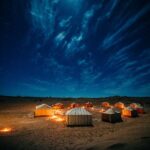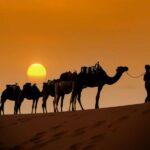Many people are considering traveling to Morocco, but they have no idea where to go? what to visit and what to explore? Thus, it’s crucial to know what is Morocco famous for before traveling to this breathtaking destination. This would help you in organizing and choosing which places to visit and which to avoid.
Morocco, is captivating North African country, famous for its vibrant history, diversified landscapes, and rich cultural heritage. It is a land of remarkable contrasts, where ancient traditions seamlessly merge with modern progress, bordered by the Atlantic Ocean, the Mediterranean Sea, Algeria, and the disputed Western Sahara. Furthermore, Rabat is Morocco’s Capital city, and Casablanca is the largest city in Morocco, it is an economic hub with a thriving business and financial sectors. Morocco has been influenced by Berber, Arab, and European cultures making it a lovely destination for every visitors.
Additionally, Morocco is a great destination for people wanting to experience variety of landscapes, and attractions. From its lovely golden dunes of the Sahara Desert of Merzouga, Imperial cities of Fes, Marrakech, Rabat and Meknes, to its breathtaking coastal cities of Essaouira, Agadir, Assilah and more.
Moroccan Traditions:
Moroccan customs and traditions are strongly founded in a blend of Berber, Arab, and Islamic influences, which shape the country’s distinct cultural character. Hospitality is a basic principle, with guests being greeted and offered mint tea as a gesture of welcoming and respect. Additionally, Traditional Moroccan clothing, such as the djellaba and kaftan, is commonly worn on important occasions such as Eid al-Fitr, Eid al-Adha. Weedings and parties.
Hammams:
Hammam, also known as a Moroccan bath. It is a type of traditional public steam bath commonly found in Morocco, Turkey, and other Middle Eastern and North African countries. The hammam is based on ancient Roman and Islamic bathing customs. It is a fundamental part of many communities’ daily lives, offering both hygiene and relaxation. Iit serves as a social and cultural meeting place.
Hammams have been a vital part of Islamic culture for centuries. It is Influenced by Roman and Byzantine bathhouses. Hammams spread across the Islamic world due to religious and social traditions that emphasize cleanliness. In Morocco, bathing is an essential ritual before prayer, which is why hammams are often located near mosques. Today, they remain an integral aspect of Moroccan culture, serving people of all ages for both hygiene and well-being.
Moroccan Cuisine:
Moroccan food is a delicious mix of Berber, Arab, Mediterranean, and African flavors. Additionally, It is one of the world’s most unusual and well-known cooking practices. People love its strong spices, slow-cooked meals, and dishes that have just the right amount of sweet and savory tastes.
Tagine, a stew made with meat, vegetables, and spices like saffron, cumin, cinnamon, and ginger that is cooked slowly in a cone-shaped clay pot that makes the flavors better, it is one of the most well-known meals. Another important food is couscous, a fine semolina grain that is usually steamed and served with meat, chickpeas, and veggies. It is often eaten with the whole family on Fridays as part of a big meal.
The Moroccan cuisine is also famous for its distinctive pastries, including pastilla, a flaky pie that is filled with pigeon or poultry, almonds, and cinnamon, combining both sweet and savory flavors. During Ramadan, Harira is a soup that is thick and hearty, containing tomatoes, lentils, chickpeas, and seasonings, it is frequently consumed as a means of breaking the fast.
Moreover, Khobz, or bread, is a fundamental component of every meal. It is used to gather up food in place of utensils. The country’s signature beverage, mint tea, is frequently paired with Moroccan desserts, including chebakia (sesame and honey cookies) and sellou (a combination of almonds, sesame seeds, and flour), which symbolize hospitality. Mint tea is prepared with fresh mint leaves and sugar. Street cuisine is also a significant aspect of Moroccan culinary culture, with popular options such as maakouda (potato fritters), sardine sandwiches, allowing visitors to immerse themselves in the tasty Moroccan cuisine.
Moroccan Medinas:
The Moroccan medina, a historic old town that is present in numerous locations throughout Morocco, is famous for its traditional architecture, bustling souks (markets), and narrow, winding streets. Mosques, riads (traditional houses), fountains, and madrasas (Islamic institutions) are frequently present in medinas, which are frequently enclosed by ancient walls. Some of the most well known medinas are Fez Medina, which is a UNESCO World Heritage site and is location of the world’s oldest university, Al-Qarawiyyin, and Marrakesh Medina, which is famous for its vibrant souks, historic palaces, and Jemaa el-Fnaa square. Medinas are cultural centers where artisans sell handmade products, including spices, leather, pottery, and textiles offering an authentic shopping experience.
Moroccan Souks:
Morocco is famous for its traditional marketplace, offering a vibrant and immersive shopping experience. These bustling souks are known for their lively narrow, winding alleys filled with stalls and shops selling a diverse range of goods, including handmade carpets, leather products, spices, jewelry, lanterns, and textiles.
Additionally, souks are typically organized into shops based on the type of merchandise, with skilled artisans crafting and selling their unique products. Among the most famous souks are those in Marrakech, near Jemaa El-Fnaa square, and in Fez, famous for its traditional tanneries and intricate handicrafts.
When strolling through the lively Souks, bargainning is an integral part of the shopping experience, as both locals and visitors negotiate prices with merchants. More than just marketplaces, Moroccan souks serve as cultural hubs where travelers can immerse themselves in the country’s rich traditions, aromatic scents, and dynamic atmosphere.
Morocco’s History & Architectural Wonders:
Morocco is a country that has a rich history, with a lot of historical monuments and architectural sites. The country has been a land of civilizations, including Berbers (indigenous Amazigh), Phoenicians, Romans, Saadians, and Arabs. Therefore, Morocco is famous for a great number of historical landmarks and sites including Madrasas such as Bouaanania Madasa, Attarine Madrasa, and Ben Youssef Madrasa. In addition to that, the country is home to some of the most well-preserved Roman ruins in North Africa, such as Volubilis, an ancient archaeological site located near Meknes. Additionally, Moroocco is known for its clay mud Kasbah including Ait Ben Haddou, Ameridile Kasbah, and Tourirt Kasbah.
Hospitality and Friendly people:
Moroccans are kind and inviting. Whether in cities or Berber villages, visitors are greeted with warmth, mint tea, and respect. Don’t be shocked if people offer you to share their meal or have lunch together Moroccans are generous and like sharing love and goodwill with tourists.
Hospitality is an important aspct in the coulture. If you’re visiting or staying with locals, you’ll likely be served tea usually mint tea. There, it’s somewhat of a love language. Even if you are a stranger, Moroccans will walk out to help you.
Filming site & Marvelous Landmarks:
If you are visiting the city of Ouarzazate, you should not miss out the opportunity to visit the film Studio of Ouarzazate, a great spot where several movies have been filmed like Gladiator, Game of Thrones and The Mummy, not only that, but also Ouarzazate has some of the best ancient clay mud kasbahs including Ait Ben Haddou kasbah, which is a UNESCO world heritage site and best destination for film makers. Lastly, Ouarzazate’s diverse landsapes, its rocky desert, and breathaking oasis makes it an ideal destination films. The city is known as ”Hollywood of Africa” due its importance in the film industry.
Morocco Sahara Desert:
Morocco is well-known for its beautiful deserts. Merzouga desert, is a must-see destination for those looking to enjoy an unforgettable experience. Moreover, Merzouga’s Sahara desert is a one-of-a-kind desert destination known for its high golden dunes. It offers a variety of activities such as camel trekking, quad rides and horse riding. In addition to overnight stays in the middle of the desert, where visitors can enjoy stargazing and the peaceful atmosphere of the desert.
High Atlas Mountains:
Morocco is famous for its High Atlas Mountains, a breathtaking range that extends from Morocco’s western region to the Sahara Desert. Visitors can appreciate its valleys, oasis, nature, and magnificent Berber villages. Furthermore, The High Atlas Mountains offers the chance to go hiking or trekking through the magnificent Mountains and explore the rural life of Morocco.
Imperial cities of Morocco:
Each of Morocco’s Imperial cities has played a vital role in the country’s political, cultural, and historical development. Morocco has four imperial cities: Fes, Marrakech, Rabat, and Meknes, each presenting a fusion of culture, history, and attractions. Moreover, visitors visiting Morocco’s imperial cities may discover its blend of historic attractions, providing insight into the country’s past. From the old medieval Medina of Fes to the vibrant souks of Marrakech and the Gates of Meknes, Morocco’s imperial cities together present a tapestry of history, allowing visitors to explore its ancient Medinas, exquisite palaces, and historic sites.
Morocco’s Diverse Landscapes:
Morocco is an exquisite destination famous for its hospitable people, vibrant culture, and diverse landscapes. The country presents an abundance of natural wonders, and breathtaking landscapes including its striking green valleys, deserts, gorges, and the magnificent Atlas Mountains. Therefore, Whether you are eager to go hiking in the mountains, surfing in Taghazout, or exploring the Todra Gorge, Morocco offers something for every nature lover.
Morocco’s Famous Agan Oil: Liquid of Gold:
Agan oil is a precious oil that is exclusively available in Morocco. In contrast to any other country, Morocco grows Agan trees. One of the most valuable oils in the world. it is derived from nuts of Agan trees. This natural oil, which is known as “liquid gold,” is well- known globally for its extensive medicinal, cosmetic, and nutritional properties. However, in order to produce one liter of Argan oil, you will need around 25 kilograms of Argan fruits. Additionally, Argan oil has a various uses, it can be used for skin, nails, and hair…etc.
Check out: Morocco Todra Gorge
Conclusion:
Morocco is famous for more than simply its sites and attractions, it is also well-known for the welcoming and inspiring atmosphere. Exploring the old medinas, enjoying mint tea in the highlands, or riding camels in the desert. Morocco is a rich country offering visitors an unforgettable experience with memories lasting for lifetime.








